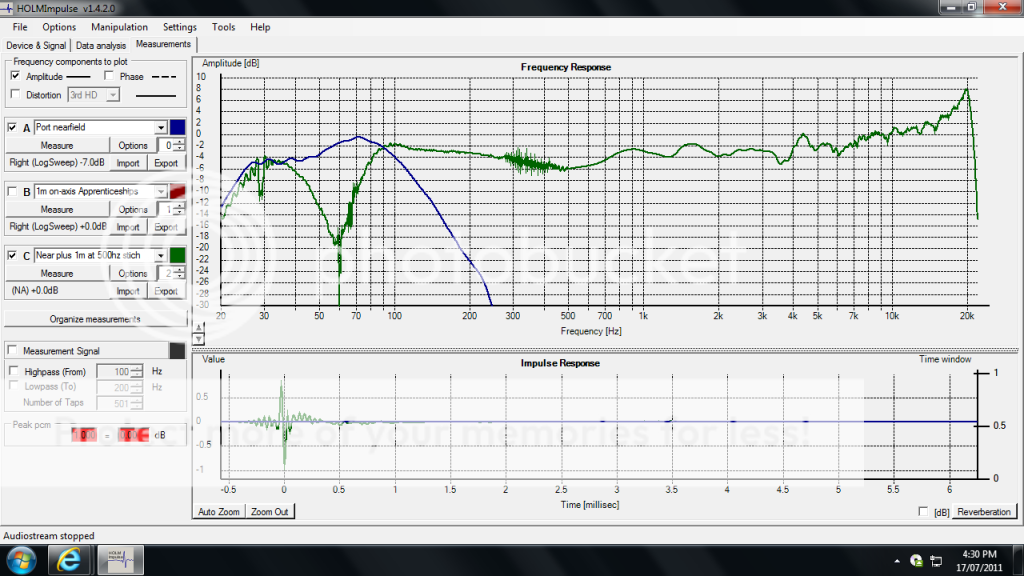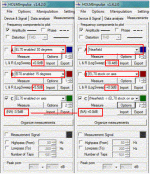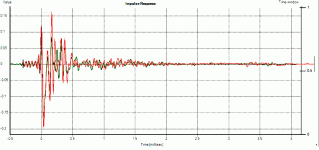"Not really" what? Are you saying that the acoustic polarity of horns varies from moment to moment? I've done a few thousand speaker measurements with direct radiators and never seen that happen.
Those are offsets for each FR display, IIRC. It's an option for presentation that does not affect the measurement.The settings for the impulse look different to me - or am I missing something?
Dave
Last edited:
Agreed if the full bandwidth is to be analyzed, though the upper range, the area most affected by the application, will likely change very little, since the window stop markers, as set, likely won't show much difference. The low end will change and the midrange somewhat. The bigger issue for the lower midrange down is the question about the start time marker.Don't know that I'd characterize it that harshly, but it is certainly true that to compare measurements and try to draw conclusions, the conditions have to be controlled a lot better.
Even given that, I don't think that there would be enough change with the settings to significantly alter most of the treble range. There is still enough to make a basic judgement in the treble, where the effects are supposed to be the most noticeable. I agree with John's assessment.
Dave
I have seen a few horns and one sub measured like that on the net. I don't recall any of my personal measurements showed that either. But I don't think it's reversed polarity. When I was doing some simulation in Axidriver I do recall that a few horn configurations did show something similar, and I thought it was reversed polarity until some configurations came up the right way."Not really" what? Are you saying that the acoustic polarity of horns varies from moment to moment? I've done a few thousand speaker measurements with direct radiators and never seen that happen.
But I don't think it's reversed polarity.
Look at the impulse responses again. One in inverted in polarity with respect to the other. I seriously doubt that the little painted spots cause that- it's far more likely from the measurement setup.
I'm not sure that there's a reversal. These are two different drivers, not one pre- and post-treatment. Since this is a "full-range" driver, rather shallow, the upper frequency range in the impulse (maybe the small dust cap?) appears to mixed in with the rest of the cone output. Add in that there's no indication of exact placement of the mic when changing the drivers/boxes. It looks to be the difference in the impulse that is reflected in the FR differences, mostly in the upper end that will be closer to relative time zero of the impulse.I'm curious about why the polarity is reversed from one measurement to the other? Amplitude is a bit different too, which might mean the speaker-to-mike position was not constant.
Examine the impulse pre-ringing. The two look nearly identical.
Dave
Last edited:
Let's make sure we're talking about the same impulse responses. I'm talking about Post 1094. One starts with a sharp spike going up, then a wider one going down. The other starts with a sharp spike going down, then a wider one going up.
But yes, they're messy for sure.
But yes, they're messy for sure.
Yes, Post 1094. I edited my post above just as you posted, to add the comment on the pre-ringing. This, though, won't alter the FR, only the phase that is not at issue. The impulse is too messy as you say. I don't think that this is related to the measurement conditions, it's simply because of the impulse of the drivers. A high end FR response as shown is going to have a messy impulse response.Let's make sure we're talking about the same impulse responses. I'm talking about Post 1094. One starts with a sharp spike going up, then a wider one going down. The other starts with a sharp spike going down, then a wider one going up.
But yes, they're messy for sure.
Dave
Last edited:
I'm curious about why the polarity is reversed from one measurement to the other? Amplitude is a bit different too, which might mean the speaker-to-mike position was not constant.
The polarity is easy to answer. My soundcard flips the polarity, and I probably just forgot to click the "invert impulse" feature in the options section of the second measurement.
As for the amplitude difference... That's harder to answer. The mic distance should have been within centemeters. I did have to change the speakers between measurements. It's more likely that when I turned down the volume to take the nearfield measurement, I didn't turn it back up to the same spot (although I though I had).
Those are amplitude offsets, that I used to make the data presentable. I have never really paid much attention to the impulse, other than setting my gate and making sure it's clean. I did find these were not very clean. Here is an example of another speaker I measure the same day in the same conditions:

It's not zoomed in, but you can see that it is much cleaner. I also wear ear plugs, so if the amplitudes were different, I wouldn't have noticed likely.
Sorry for the sloppy data guys. If it's easier to compare, I can invert that one and repost the image.
Thanks, 'vic. I think that if you want to get meaningful comparison data (which will be pretty fine grained), you have to control the measurement parameters more closely than you would need to to merely get usable data for a speaker design. And given the rather messy response of this driver, I'd want to repeat the measurement after doing the driver change, i.e, measure A, measure B, then measure A again, then measure B again, in that order. This will allow others to get a handle on what the test variability is.
^ Fair enough. The speakers are back with Dave, so that won't be done. But maybe for next time 😀
Do you believe the frequency response data is still worth while? Seems accurate enough to me. The off axis stuff is rough, as my mic gets closer to a wall moving off axis 🙁 I was shocked by Bud's claims of improved off axis response. I know enable is most popular among full range users, and off axis behavior is poor on full range drivers (typically). So I thought, hmm, maybe that is part of it and why it's so popular. So I specifically wanted to measure the off axis frequency responses.
Even if that part isn't reliable, well, my ears are, and they sounded identical off axis :/
Do you believe the frequency response data is still worth while? Seems accurate enough to me. The off axis stuff is rough, as my mic gets closer to a wall moving off axis 🙁 I was shocked by Bud's claims of improved off axis response. I know enable is most popular among full range users, and off axis behavior is poor on full range drivers (typically). So I thought, hmm, maybe that is part of it and why it's so popular. So I specifically wanted to measure the off axis frequency responses.
Even if that part isn't reliable, well, my ears are, and they sounded identical off axis :/
Ya got me. 😀 The drivers are messy enough that they could be a significant contributor to test variability (i.e., source noise rather than detector noise). Hard to say in retrospect.
The dispersion thing doesn't seem very plausible, but some data backing up the claims would be a nice thing.
The dispersion thing doesn't seem very plausible, but some data backing up the claims would be a nice thing.
Look at the impulse responses again. One in inverted in polarity with respect to the other. I seriously doubt that the little painted spots cause that- it's far more likely from the measurement setup.
SY is right. I have a comp in the making and when i flipped one curve vertically, they almost fall on top of each other.
dave
This would be an interesting test, but one would need to be very careful in the measurements and setup. Putting the impulse into dB scale would show potential differences better.
Thanks Dave! You're good at that. I can try and combine the two (with proper inverting) within holm. And if anyone wants, I can give the measurement files. Kind of inconclusive though :/
Those are offsets for each FR display, IIRC. It's an option for presentation that does not affect the measurement.
Dave
OK thanks.
- - - - - - - - - - - - -
Interestingly, the higher impulse response for the EnABL'd driver is consistent with my anecdotal listening impressions. It will be interesting to see if a similar trend is shown in future impulse response measurements.
Last edited:
And if anyone wants, I can give the measurement files. Kind of inconclusive though :/
Clear all but the two we want to see and save it under a new name. Post the zip here. It should not be too big.
- Home
- Loudspeakers
- Multi-Way
- EnABL - Technical discussion

